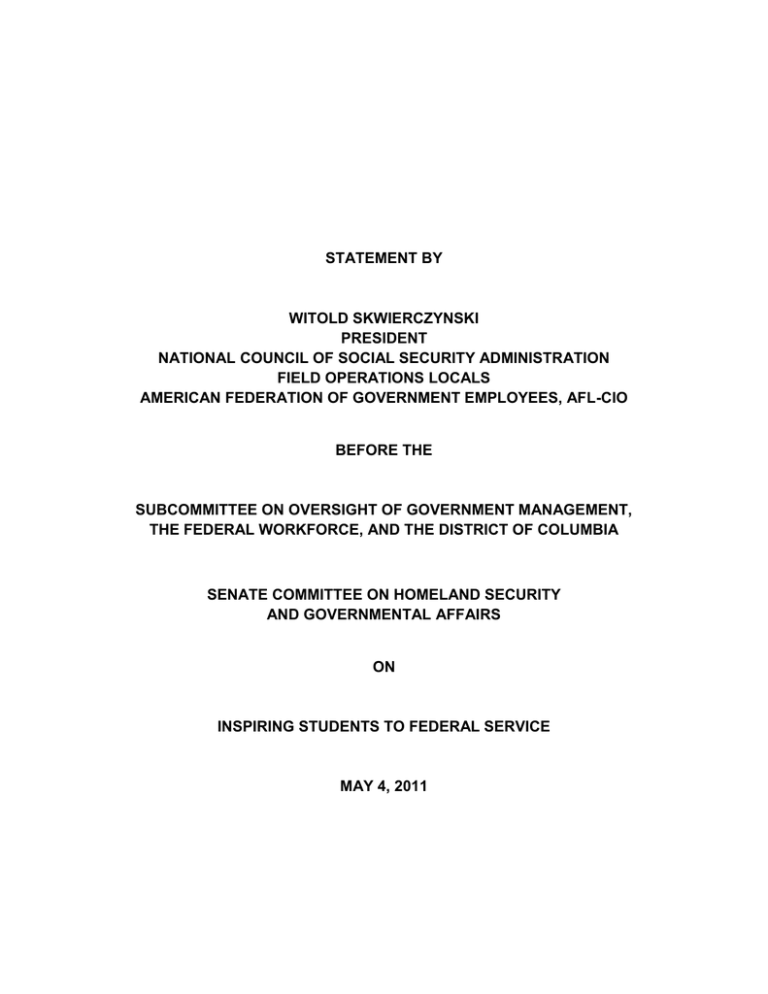Inspiring students to federal service
advertisement

STATEMENT BY
WITOLD SKWIERCZYNSKI
PRESIDENT
NATIONAL COUNCIL OF SOCIAL SECURITY ADMINISTRATION
FIELD OPERATIONS LOCALS
AMERICAN FEDERATION OF GOVERNMENT EMPLOYEES, AFL-CIO
BEFORE THE
SUBCOMMITTEE ON OVERSIGHT OF GOVERNMENT MANAGEMENT,
THE FEDERAL WORKFORCE, AND THE DISTRICT OF COLUMBIA
SENATE COMMITTEE ON HOMELAND SECURITY
AND GOVERNMENTAL AFFAIRS
ON
INSPIRING STUDENTS TO FEDERAL SERVICE
MAY 4, 2011
Mr. Chairman and Members of the Subcommittee:
My name is Witold Skwierczynski. I am President of the American Federation of Government
Employees (AFGE) Council of Social Security Administration Field Operations Locals. On behalf
of AFGE, which represents 625,000 federal employees in 65 agencies throughout the nation, I
thank you for the opportunity to testify today on the subject of inspiring students to federal
service. AFGE is proud to represent federal government workers because they are the vital
threads of the fabric of American life. AFGE members inspect the food we eat and the places
we work. They protect us from environmental dangers, and develop treatments and cures for
our illnesses and diseases. They protect us from the flow of illicit drugs, maintain the safety of
our nation’s borders, and protect our communities by incarcerating dangerous felons. They
keep our airways and homeland secure from terrorism and our warfighters prepared for any
danger. They care for our nation’s veterans, serve as a vital link to Social Security recipients,
and make the dream of homeownership a reality for millions of Americans.
Hiring the next generation of federal employees is a serious undertaking. Those charged with
the task have both a legal and social responsibility to conduct federal hiring in the most open,
fair, and competitive way possible, and the plain fact is that openness, fairness, and
competition take time. Federal agencies have a legal and moral responsibility to honor
veterans’ preference. Internal candidates who were selected into career ladder positions must
be given the opportunities they have been promised. Background checks must be conducted.
Information regarding education and prior employment must be verified. Working for a federal
agency is not the same as working at a private firm, and it takes time to make sure an applicant
meets the standards and requirements our society expects the federal government to uphold.
AFGE applauds President Obama’s Executive Order 13562 (issued December27, 2010), which
repealed the Federal Career Intern Program (FCIP), a widely discredited hiring system that
made a mockery of the Merit System and its promise of open competition for federal jobs, as
well as veterans’ preference.
In addition, the Executive Order created the Pathways Programs, three programs tailored to
recruit, train and retain well-qualified candidates:
the Internship Program for current students,
the Recent Graduates Program, which will place successful applicants in a two-year
development program prior to achieving conversion to career jobs, and
the Presidential Management Fellows (PMF) Program, which is tailored to advanced
degree candidates.
Because the Office of Personnel Management (OPM) regulations for implementation of the
three Pathways Programs are still in development, it is, of course, too early to tell what these
programs will look like in final form and whether they will avoid the pitfalls that plagued the
FCIP. AFGE, however, continues to urge that the regulations ensure that the programs use
appropriate merit-based procedures for recruitment, provide for equal employment
1
opportunity, apply veterans’ preference procedures, and comply with all applicable laws. AFGE
understands the need for qualified students, recent college graduates, and advanced degree
graduates to move into the federal workforce. But this should not be done at the expense of
qualified veterans and current federal employees, many of whom are ideal candidates for hiring
or promotion. This is why AFGE wants to ensure that these new programs will not reduce the
opportunities for promotion of the current workforce and are also directed at appropriate
numbers and types of vacancies.
Political Climate for Federal Employees and Retirees
OPM Director John Berry has noted several times the desire of the Obama Administration to
make government service “cool” again. We strongly agree that it is important to support in
concrete ways our nation’s public servants, and to educate the public about the value of their
service to America. If we do this, it will certainly be easier to attract the best and the brightest
to federal service.
Unfortunately, however, the current political climate for all public employees, including federal
employees, is harsh. Efforts are underway throughout the country to eliminate pensions,
severely curtail health insurance benefits, cut or freeze pay levels, contract out government
work, and eliminate longstanding collective bargaining rights. In particular for federal
employees, the two-year pay freeze proposed by the President and enacted by the Congress is
effective this year and next, but there are those who advocate a five-year pay freeze, including
freezing all performance-based step increases and bonuses.
Federal Employees Health Benefits Program (FEHBP)
One of the proposals included in the Simpson-Bowles deficit reduction plan advocated turning
the Federal Employees Health Benefits Program (FEHBP) into a voucher system, with
astonishing cuts to the government’s contribution to premiums. Based on AFGE’s conservative
calculations, if that particular proposal were to become law, by the year 2030 federal
employees and retirees would, on average, pay 63% of health insurance premiums, rather than
the 33% they pay today.
In addition, the Simpson-Bowles proposal recommended reducing the government’s share of
health insurance premiums for federal retirees. This proposal is presented as an effort to follow
the private sector in the race to the bottom. While it is true that many private firms have
broken promises to employees to provide health insurance support in retirement, that is
behavior that a Presidential commission should deplore, not seek to emulate.
There are good ways to save money by reforming the FEHBP without taking away benefits from
federal retirees, all of whom were promised that the government’s share of their health
insurance costs in retirement would continue on par with those still in the federal workforce.
2
FEHBP is an inefficient and poorly structured program with high overhead costs, and high
profits guaranteed to the health insurance plans that participate. OPM has also refused to take
advantage of rebates for prescription drug costs available to employers that provide such
coverage to their retirees. If the true goal of Simpson-Bowles is budget savings, that can be
achieved without reducing health insurance benefits or shifting costs onto employees and
retirees.
Federal Retirement
Further, the Simpson-Bowles report recommended numerous cuts to federal retirement,
including:
changing the benefit formula from a high-3 basis to a high-5 basis, which we estimate
will cut retirees’ annuities by three to five percent;
vastly increasing the amount that employees enrolled in the Federal Employees
Retirement System (FERS) would be required to pay for these reduced annuities;
reducing cost of living adjustments for FERS and Civil Service Retirement System (CSRS)
retirees; and
raising the retirement age for Social Security.
According to the most recent Congressional Research Service (CRS) report, while CSRS can be
described as having an unfunded liability of $674 billion, FERS has a deficit of just $0.9 billion.
Even these “deficits” are irrelevant, according to CRS, as the trust fund out of which benefits
are paid “is not in danger of becoming insolvent.” None of the proposed cuts to FERS or CSRS is
necessary to close a funding gap because both systems are on sound financial footing. The CRS
report quotes OPM on the ability of the retirement trust fund to cover all benefits under
promised current law: “the total assets of the CSRDF, including both CSRS and FERS, continue to
grow throughout the term of the projection, and ultimately reach a level of about 4.1 times
payroll, or about 19 times the level of annual benefit outlays.”1 Because these systems face no
financial problem or risks, there is no reason to cut benefits or change the financing formula.
High 3 to High 5
The proposed change from “high 3” to “high 5” as a basis for calculating annuities would mean
a cut in retirement benefits of anywhere from 3 to 5 percent a year, depending on length of
service. Combined with the impact of the two-year pay freeze – threatened by some to be
extended to five years, this proposal represents a significant lifetime cut in compensation that
will only drag down morale, recruitment, and retention for an entire generation.
1
Civil Service Retirement and Disability Fund, Annual Report of the Board of Actuaries, Civil Service Retirement and
Disability Fund, Fiscal Year Ended September 30, 2009, p.18.
3
Increasing Employee Contributions to Retirement
When the 1983 Social Security amendments mandated inclusion of federal employees into the
system, Congress and President Reagan replaced CSRS with FERS. FERS was designed to be less
costly to the government and to require a greater contribution from employees if they aimed
for a retirement benefit equivalent to CSRS. Employees pay 0.8% of salary for their annuity,
another 6.2% of salary for Social Security, and 5% of salary in order to obtain the government’s
full match to the Thrift Savings Plan (TSP). CSRS employees do not pay into Social Security, but
pay a total of 7% of salary for their defined benefit pension. Thus, under current law, FERS
employees must pay 12% of salary to get a benefit as good as CSRS.
The draconian proposal suggested first by The Third Way, a conservative Democratic think tank,
would force FERS employees to contribute approximately 7% more to the defined benefit
pension. If enacted, FERS employees would thus have to pay over 18% of salary toward
retirement. Most AFGE members would be unable to afford this. In order to make ends meet
for their living expenses and responsibilities to their families, they would have to eliminate their
contributions to the TSP. The result of that, of course, if that they would lose investment
earnings from their own contributions as well as the government match.
If this proposal becomes law, FERS employees, who now constitute 88% of the federal
workforce, will be brought down to the level of many irresponsible private employers.
Providing inadequate or no retirement benefits in the private sector should not become
normative for public sector employers. The fact is that the FERS three-component plan, with
Social Security, a defined benefit annuity, and a 401(k)–style savings plan is just like the
responsible private sector standard, and the federal government should not aim to match what
the worst employers in the private sector get away with. (It should be noted that recent
legislation introduced in the Senate would eliminate completely the modest defined benefit for
FERS employees.)
“Chained” CPI
AFGE also strongly opposes the Simpson-Bowles’ recommendation to substitute a new, inferior
measure of inflation called the “chained” Consumer Price Index (CPI) in order to lower COLAs
for federal retirees. This proposal would hit FERS retirees twice, because the measure would
reduce COLAs for both federal annuitants and Social Security recipients. The so-called “chained
CPI” is a highly controversial method for lowering the official measure of inflation. The current
CPI measures increases in the prices of the goods and services the typical household buys. The
“chained” CPI says if the price of something goes up, instead of counting that increase,
substitute the price of another good or service whose price either stayed the same or went up
by less. For example, if the price of beef went up, the “chained” CPI would not include that
price increase in its calculation. Instead, it would assume that people would be just as well off
if they substituted a lower-priced animal protein in their market basket. The chained CPI
literally takes the inflation out of the formula for measuring inflation. This method “cooks the
4
books” to pretend inflation is lower than it is, thereby depriving annuitants and other retirees
of the inflation protection that cost of living adjustments are meant to provide.
Social Security Retirement Age
The Simpson-Bowles proposal also suggested gradually raising the age for eligibility for full
Social Security benefits in retirement from 67 to 69. The age for early eligibility with reduced
benefits would rise from 62 to 64. This cut in Social Security benefits would disproportionately
affect minorities and those in jobs that are physically demanding. Today, 25% of all workers
age 60 and 61 report a health condition that limits their ability to work, yet this proposal would
require them to work almost a decade beyond this age for full benefit eligibility. Although the
Commission says it would support a “hardship” exemption for some workers in particularly
physically-demanding occupations, it would not cover all workers with health problems that
limit their ability to continue working into old age.
Further, the increases in life expectancy that the Simpson-Bowles proposal uses for justification
are hugely correlated with income. According to data from the Social Security Administration,
the life expectancy of men in the bottom half of the income distribution has risen by just 1.1
years between 1982 and 2006, while those in the top half experienced a 6 year increase in
longevity. During this period, the age for eligibility for all workers has risen by 8 months, but
the Simpson-Bowles proposal wants to make this problem worse. A hardship exemption will
not apply to half of all workers, and half of all workers will have already had their increase in life
expectancy accounted for when the full benefit eligibility age rises to 67 by 2027.
Contracting Out Federal Government Work
Finally, federal workers in the Department of Defense (DoD) are under attack because of
Secretary Robert Gates’ controversial “Efficiency Initiative”. It’s not that there shouldn’t be an
“Efficiency Initiative”—of course, DoD should always be striving to become more efficient. It’s
not that civilian employees shouldn’t be asked to sacrifice if the department’s budget is
rationalized. However, it is clearly wrong for the Pentagon to insist that civilian employees
make additional sacrifices because service contractors aren’t actually being asked to make any
meaningful sacrifices.
The failure to include service contractors reveals the “Efficiency Initiative” to be a sham. At a
time of budget stringency, it makes no sense not to closely scrutinize the hundreds of billions of
dollars DoD service contractors bill to the American people. The Pentagon’s failure to even
account for service contractor costs, let alone control and reduce those costs, means that
actual savings can never be realized. It also likely means that non-DoD departments will be
asked to make even greater sacrifices to make up for the savings DoD cannot achieve because
of its stubborn over-reliance on expensive service contractors.
Under the “Efficiency Initiative”, the department’s civilian workforce is capped at FY10 levels.
Pentagon officials have misleadingly referred to this as a “freeze”. In fact, an FY10 cap will
5
actually require tens of thousands of civilian positions to be eliminated. There is talk that the
Army alone will have to reduce its workforce by 33,000 civilians over the next several years.
Moreover, the cap is onerously applied. In Secretary Gates’ words, only “very limited
exceptions” are to be allowed. As a practical matter, secretarial approval will be required
before a manager or a commander can add in-house staff.
Although Pentagon officials talk about 10% cuts in service contracts, they are not talking about
DoD service contracts generally, which cost taxpayers at least $150 billion annually; rather, they
actually mean that the costs of a narrow subcategory of service contracts will be reduced by
10%--which, according to Secretary Gates, will result in less than $6 billion in savings over three
years. I’ve heard more than one incredulous observer remark that such savings are “a drop in
the bucket”. In fact, given the amount of taxpayer dollars spent on service contracts over that
period, such savings actually constitute a microbe in a drop in the bucket. Needless to say,
there is no special approval required before the department may undertake new contracts or
expansions of existing contracts. Indeed, according to the House Appropriations Subcommittee
on Defense, the Administration’s FY12 budget request would significantly increase service
contracting costs.
What does this mean in practical terms? New work and expansions to existing work will be
automatically contracted out—even if we can do the work more efficiently or the work is
inherently governmental. Although DoD concedes that insourcing has been “highly successful”,
it is obviously difficult for any meaningful insourcing to occur if no new civilian employees can
be added—even if civilian employees can do the work more efficiently or the work is inherently
governmental. The Pentagon, despite protestations to the contrary, has erected a series of
bureaucratic roadblocks in order to prevent even inherently governmental acquisition work
from being insourced. In other words, DoD is deliberately allowing contractors to continue to
award contracts and oversee other contractors. In fact, activities that insourced successfully
are being punished because now they must eliminate a comparable number of positions in
order to get back down to FY10 levels. And because the civilian workforce is being reduced to
achieve an arbitrary target, work that we are currently performing will likely have to be
contracted out—even if we can do the work more efficiently or the work is inherently
governmental.
Why won’t the Pentagon allow the civilian workforce to be managed by budgets and workloads
instead of by arbitrary constraints? If an activity has funding and workload, why can’t it use
civilian employees or contractors—depending on the usual criteria of cost, policy, risk, and the
law? Why must those activities sometimes be forced to use contractors—even if civilian
employees can do the work more efficiently or the work is inherently governmental? In a time
of budget stringency, why does the department insist on tying the hands of its managers and its
commanders and forbid them from using civilian employees in certain situations? Obviously,
the “Efficiency Initiative” undermines the interests of warfighters and taxpayers alike; and it is
completely contrary to the Administration’s ostensible attempt to control defense spending.
It’s also contrary to the law. The department is forbidden from applying arbitrary constraints
on the size of its civilian workforce, from not using the more efficient workforce (consistent
6
with military needs), and from failing to give “special consideration” to insourcing certain
functions. In fact, AFGE counts the department as acting in defiance of eleven different
sourcing and workforce management laws. Congressional experts insist that is merely the
short-list.
DoD’s “Efficiency Initiative” has put the civilian workforce back into a death spiral. With no new
work, no new staff, and no new promotional opportunities, in-house workforces can’t help but
become less productive and thus become vulnerable to even the most outrageous privatization
schemes. Beginning in 2007, the Congress undertook a bipartisan effort to make the sourcing
process more accountable to taxpayers and less unfair to civilian employees. The “Efficiency
Initiative” threatens to undo all of that work. Last summer, Secretary Gates told The
Washington Post that “federal workers cost the government 25 percent less than contractors.”
That the department is poised to repeat so soon the utterly discredited and ruinous
downsizing-driven privatization policies of the 1990’s is a sad testament to Secretary Gates’
failure to heed his own well-reasoned analysis.
Conclusion
To say the very least, Mr. Chairman, unless these efforts to destroy the image and middle-class
status of federal employees are not halted, it will not make a bit of difference if the Obama
Administration creates the best possible recruitment programs for student interns, and recent
undergraduate and graduate students. A candidate with any sense at all would be reluctant to
join a workforce which is constantly being maligned and financially undermined for political
purposes.
That concludes my testimony. I will be happy to respond to any questions.
7
Witold Skwierczynski
Witold Skwierczynski is President of the American Federation of Government
Employees (AFGE) National Council of SSA Field Operations Locals, Council 220.
Witold was born in East Chicago, Indiana. He graduated from the University of
Notre Dame in 1972. His federal career began in March 1973 and he soon
became active in AFGE at his Local in Chicago, Illinois. In November of 1983, he
was elected the President of Council 220 and has served as President ever since.
In 2001, Witold moved to Baltimore, Maryland and is an active member of Local
3302.
{00290123.DOCX - }
8





